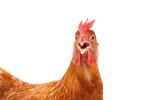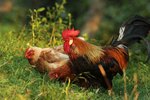Guinea fowl, also known as Guinea hens and ginny birds, are a small poultry breed weighing only 3.5 pounds. The helmeted Guinea fowl originated in West Africa, and domestic Guinea fowl evolved from this species. They are in the same poultry group as pheasants and turkeys, but not chickens. Their main diet consists of ticks, beetles and other garden insects. They peck at the ground, picking up bugs, but do not scratch the ground like chickens.
Laying Eggs

The easiest way to tell a female, or hen, from a male, or cock, is when they are adults. When a hen lays her eggs, she prefers to roost in a tree or a field, where she lays up to 30 eggs, or one egg per day. She may lay her eggs from the end of March through mid-May. These eggs are about two-thirds the size of a regular chicken egg.
Wattle
Both male and female Guinea fowl have a wattle. The wattle is a fleshy growth on the bird’s neck under the beak. When Guinea fowl are young, between 12 to 15 weeks of age, the male's wattle is more prominent than the female's. The male’s wattle has thicker edges and curves out more from the neck than the female's. Between 15 and 16 weeks of age, the female's wattle also begins to thicken, though the male’s remains larger into adulthood.
Size
The size of the helmet, a backward-curving bony growth, on the Guinea fowl’s head is larger on a cock than on a hen. The cock also has a head that looks coarse and not as smooth as a hen’s head. In addition, the cock is larger than the hen. Many times, these differences are so slight as to appear non-existent. It takes a trained eye and experience to distinguish a Guinea cock from a Guinea hen by physical appearance.
Guinea Fowl Cry
Both hens and cocks have an unusual cry, but most often this cry is the best way to tell the difference between sexes. The cock’s cry is a single syllable note, or more of a shriek, whereas the hen's cry is two syllables. The cock never makes the two-syllable cry. Many say the male's call sounds as if he is saying “wheat,” and the female's call sounds as if she is saying “buck wheat” or “qua-track qua-track.” Young cocks start making their cries as early as six to eight weeks. Hens generally do not start until much later.
References
Photo Credits
-
Jupiterimages/Photos.com/Getty Images
Writer Bio
Diana David began writing when she became aware of the plight of domestic rabbits in 2001. In 2008 she posted online articles to help rabbit owners throughout the world. In 2009 she created her own rabbit rescue-related website, where she continues to post articles to this day. She holds an associate degree in computer programming from the Front Range Community College in Colorado.



